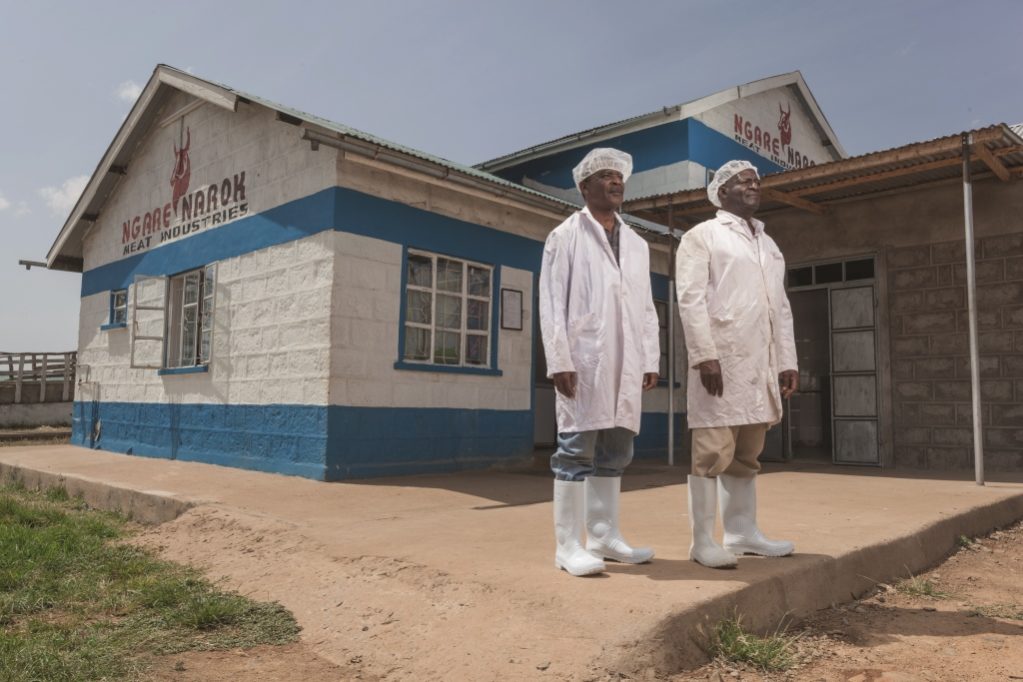It is better to own 10% of a billion dollars than 100% of ten dollars. Kenyan entrepreneur Ndiritu Muriithi lives by this philosophy. Twelve years ago, he saw an opportunity when he visited his childhood friend, Bernard Macharia, who was working as a rancher in Rumuruti, Laikipia County.
“It seemed odd to me that cattle destined for slaughter were being transported alive to Nairobi and other markets. I wondered why they were not being slaughtered at the source. After all, a pick-up truck can only ferry four to five live animals, but three times that number when they are slaughtered,” says Muriithi.
A year later, Muriithi and Macharia started Ngare Narok Meat Industries. With $34,775 as seed capital, they set up a modest abattoir that served livestock traders in the region.
“We saw a big opportunity. Every Thursday, we have a market day in Rumuruti and livestock from Samburu, Baringo and Isiolo are sold,” says Muriithi.
 Be
Be
Loading...
According to statistics from the Laikipia sub-county veterinary office, around $347,000 is exchanged at the Rumuruti livestock auction every week. The market is the second largest in Kenya after the one in Garissa in northern Kenya that is valued at more than $695,000.
Laikipia County is the Kenyan capital of ranching and the ideal place for Ngare Narok. The region has 43 registered ranches sitting on between 10,000 to 110,000 acres of land. The ranches occupy more than 50% of the total land area. The county had 189,685 heads of cattle and 623,648 sheep and goats, according to the Kenya Population and Housing Census. Macharia estimates the entire Kenyan livestock business to be valued at $23 million.
Of the 43 ranches in Laikipia, 30 are privately owned. Laikipia is home to Ol Pejeta Conservancy, East Africa’s largest black rhino sanctuary. Private ranches are used for wildlife conservancy as well as cattle rearing.
“Most ranches are owned by white Kenyans and they account for 15 to 20 percent of the cattle in Laikipia,” says Macharia.
Livestock infrastructure is supported by 50 holding grounds, stock routes and outspans, two public and three private abattoirs, five auction yards and 33 slaughter slabs.
When FORBES AFRICA visits Ngare Narok, the staff is preparing to slaughter a group of animals. The plant has a daily capacity of 50 cows and 100 smaller animals.
“When the animals are brought to us from the auction market, we have to give them about five hours to graze and rest. This allows them to relax, otherwise the meat will be hard because of their tension,” says Rajab Hassan, the General Manager of Production at Ngare Narok.
The company has also broadened its services. Instead of only being an abattoir, Ngare Narok now collects hides and skins, and produces prime beef products, organic compound fertilizer, and organically tanned leather and leather products. Initially, the business didn’t make much money but its fortunes have since improved. By 2007, it was making $31,000 and by the end of last year it had revenue of $1.8 million. Projections for the end of this year are $11.5 million.
“Essentially, we were a toll slaughter house. You brought your animals and we slaughtered for a fee. This led to a trade in hides and skins, as some butchers and meat mongers would pay for the slaughter service using the resultant hide or skin. Ninety percent of the revenue is from hides and skin,” says Muriithi.
Abattoir operations generate large amounts of offal waste. Ngare Narok had to innovate or continue spending money on its disposal. The solution was to produce organic compound fertilizer. They also started experimenting with naturally occurring herbs to tan hides and skins.
“In this business, you make money by adding value to everything. You have to utilize all the by-products to make a good return,” says Macharia.
Muriithi and Macharia were fortunate enough to have friends that believed in their business. One of them was the resident judge of the High Court of Kenya, Justice Isaac Lenaola.
“Lenaola invited his friend in 2005. In the same year, my colleague at the International Finance Corporation, Mary-Jean Ndlovu, intrigued by the story, visited the abattoir. Shortly after, she invested,” says Muriithi.
In 2009, two other potential investors showed an interest in the business. They, however, were not impressed. Their recommendation was drastic: overhaul the top management. The board and management were not taking the business seriously enough. Whereas Ngare Narok had a professional looking business plan, it lacked execution.
Muriithi decided to heed this advice.
“In mid-2011, I had a conversation with my business partner Ken Mbwaya. We were looking at how we could transform our small businesses we had invested in. These SMEs were draining our income instead of growing it.”
Mbwaya, a former HP regional boss, decided to take charge of Ngare Narok in August, 2012, and things started changing.
The renewed shareholder enthusiasm led to two successful issues of rights. They have since welcomed four new shareholders.
“In total, we raised [$460,000] in equity in 2013, most of it from YCEO Holdings Ltd, a young venture capital firm,” says Muriithi.
This year, Fanisi Capital, a private equity fund invested $2.5 million for a 40% shareholding.
Although Muriithi had the option of getting money from a bank, he says private equity offers much more.
“It comes with professional investment and expertise which allows an entrepreneur to get additional ideas that will take the business further than what a sole entrepreneur could have done.”
The downside of private equity is that investors expect high return is short spaces of time. This doesn’t worry Muriithi.
“All aspects of life involve an element of risk. The only question is how well we manage that risk.”
His vision is to make Ngare Narok a multi-billion-dollar establishment. All he wants, is to own just 10% of it.
Loading...
